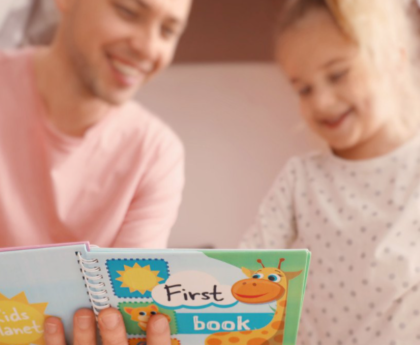What are Vocabulary Words?
Vocabulary is the knowledge of words, and vocabulary words are a specific set of words to be learned. Vocabulary is an essential component of reading comprehension. Knowing the meaning of words helps with understanding a text. Without a strong vocabulary, kids struggle to make sense of what they are reading, and they lack the necessary words to communicate through speech and writing. Teaching words and their meanings should be a core part of any reading instruction.
Vocabulary Development
Language development, which includes recognizing and responding to sounds, begins at birth, and even in their mother’s womb, babies begin to absorb sounds. But using vocabulary words with meaning typically begins around age one, when babies say their first words. The first five years of a child’s life are the most crucial for language development, but acquiring new words continues throughout childhood. During the school years, kids learn vocabulary at a rapid rate, anywhere from 2,000 to 5,000 words each year. Studies show that there is a strong correlation between the amount of vocabulary a child has and their academic achievement.
Vocabulary Acquisition: Indirect vs. Direct
Most of the vocabulary that kids learn, especially in the early years, is through indirect instruction. The more language-rich a child’s environment is, the more words they will learn indirectly. This includes engaging children in conversations, reading aloud to them, encouraging them to ask questions, and providing them access to independent reading books.
Direct vocabulary instruction generally happens during the school-aged years. It involves the intentional teaching of vocabulary words through word-learning strategies, spelling lists, shared reading, and content-area words. Direct instruction of vocabulary needs to actively engage children in practicing and thinking about the meaning of new words. It requires multiple exposures of a word for a child to fully understand it.
Some ways to help your children improve their vocabulary include:
- Explain the meaning of words in child-friendly ways that they understand, either before they begin reading or during reading.
- Help them figure out the meanings of words on their own using context clues.
- Make a sketch to depict a word by connecting it to an image that will help them remember its meaning.
- Connect new vocabulary words to known ones through semantic mapping by giving an example of the word, a synonym, and an antonym.
- Encourage children to apply the meaning of a new word to their own life by giving an example of the word using something they relate to.
- Teach students word parts and figures of speech. Knowing the meaning of root words and affixes can help them figure out new words that include these word parts. And being able to identify relationships between words and knowing figures of speech can improve their ability to learn new words.
- Develop word-consciousness in children. This means being interested in words and word meanings. It includes studying language, teaching word appreciation, and having fun with learning new words.
Frameworks for Effective Vocabulary Instruction
Here are some well-known frameworks that can be used for kids’ vocabulary instruction.
The Four-Part Approach to Vocabulary Acquisition
Developed by Michael Graves, the components for the four-part framework for vocabulary instruction, as described in The Vocabulary Book (Graves, 2006) are:
1. Providing Frequent, Varied, and Extensive Language Experiences
2. Teaching Individual Words
3. Teaching Word-Learning Strategies
4. Fostering Word-Consciousness
Using Grave’s framework, the U.S. Department of Education’s Institution of Education Sciences funded a three-year project called MCVIP. In this program, they implemented Grave’s Framework in multiple classrooms. Through their research, they were able to identify effective ways to actively teach vocabulary to students. They found that frequent, deliberate instruction as well as fostering an appreciation of words are effective in developing a strong vocabulary.
Ways to do this in the classroom include: using vocabulary graphics, teaching words for describing character traits, reading aloud to students and providing them time to read and write regularly, engaging students in language-rich conversations, teaching high-frequency words as well as domain-specific academic vocabulary, regularly practicing vocabulary taught through review activities, teaching how to use context clues and analyzing words using their word parts, and fostering word-consciousness through word-play and focusing on word categories and relationships.
Tiered Vocabulary
Another direct instruction framework for teaching vocabulary involves organizing words into three vocabulary categories with different ways to teach each one. This research-based instruction is explained in the book Bringing Words to Life by Isabel Beck, Margaret McKeown and Linda Kucan and includes word levels that are organized by frequency, complexity, and meaning.
- Tier 1 Words are the high frequency words most often used, taught indirectly through everyday conversations and reading. Examples include common words given for objects, feelings, people, animals, and places (like park, happy, baby, car, and dog).
- Tier 2 Words are medium frequency academic vocabulary words ranging across multiple content areas. They are directly taught within context and can help with reading comprehension. They are not as common in everyday conversation and can sometimes have multiple meanings. Words like summarize, calculate, analyze, and ultimate are a few examples.
- Tier 3 Words are low frequency words used only in specific domains that are needed for understanding concepts within content areas. They should be directly taught within the subjects they relate to, helping with comprehension of content knowledge. Some examples are climate, nucleus, radiation, and republic.
Teaching High-Frequency and Sight Words
Although high-frequency and sight words are most often learned indirectly, they should also be taught directly through decoding and repeated practice, starting in preschool or kindergarten.
High-frequency words are the words most commonly used. They make up approximately 50% of the words typically found in texts, and up to 80% of the words in children’s books. Practicing high-frequency words can improve a child’s ability to read and write.
Sight words are common words that are easily recognized but don’t always follow common rules of spelling. Therefore, they are words that have typically been memorized. They are also referred to as heart words, since they have to be learned “by heart.”
High-frequency words include sight words, but they also include common words that are easier to decode using phonics and spelling patterns. These are sometimes referred to as instant words or flash words, since they should be recognized instantly or “in a flash.”
Sight Word Lists
- Dolch Words List – The 220 most common sight words, organized into five levels
- Fry Words List – The 1,000 words most commonly used in reading and writing, divided into 10 levels and organized into groups of 25 words, based on difficulty and frequency of use
Free Vocabulary Practice Sites
Raising Readers lessons and books teach kids how to read over 500 unique words, including high-frequency words, sight words, and other vocabulary words. Here is a list of additional, free online sites to practice sight words and vocabulary:
- Heart Word Magic – games and activities designed to help students read and spell high frequency and sight words
- Flocabulary Word Lists – free list of vocabulary words by grade level, which include words that K-8 students are most likely to encounter on state tests, as well as an SAT vocabulary words list
- Great Schools – vocabulary wordlists for grades one through 12
- Hubbard’s Cupboard Sight Word Booklets – list of printable sight word reading books, available in several languages, corresponding to common themes and seasons
- Mrs. Jones’ Room – extensive list of sites that offer free printable mini books, including alphabet books, leveled books, and sight word books
- Sight Word Games – ideas for a variety of games to practice sight words
Free sight word printable worksheets and coloring pages:
Free sites for learning and practicing vocabulary words online:
- Freerice.com – do good by taking vocabulary quizzes to donate grains of rice
- Spellingcity.com – spelling and vocabulary games
- Education.com – vocabulary games
- Turtlediary.com – word games for pre-K-5
- Pbskids.org – vocabulary games based on PBS kids shows
- Merriam-webster.com – games, quizzes, and word of the day
- Vocabulary.com – dictionary for teaching words as well as many vocabulary lists
- Nytimes.com – vocabulary word of the day challenges
- Visuwords.com – visual dictionary and thesaurus
- Etymonline.com – etymology dictionary
- Describingwords.io – tool for finding adjectives
- Reversedictionary.org – find words by their definition
- Relatedwords.org – find words based on other related words
- Wordsift.org – copy and paste text to quickly identify the key vocabulary words
- College vocabulary lists – vocabulary.com and britannica.com
No matter where your child is on his or her reading journey, they benefit greatly from evidence-based, engaging literacy exercises. To practice effective vocabulary and reading instruction games, download the reading.com app today!





